How to use chemical weapons
After the end of World War I, CW was banned. However, it is widely used Spain in Morocco, Japan against China and Italy in Ethiopia. In World War II, chemical weapons were not used, but it was during these years that new models of chemical weapons of the second generation were created in Germany — nerve-paralytic — sarin, soman, herd. All of them were a priority of fascist Germany. However, during the war Hitler did not dare to use chemical weapons, the Fuhrer was not sure how Stalin could answer this.
But already in the second half of the last century, the title of champion in the development and use of chemical weapons passed to the United States. During the Vietnam War, Americans sprayed millions of tons of poison in the air under the designation Agent Orange, which still infect large areas of the country, and children are born with congenital mutations. The Americans used XO in Iraq, during the storming of Fallujah, they used white phosphorus, which is prohibited by international conventions. White phosphorus is a substance that, when exposed to open skin, causes burns to the bones. Upon receipt of such burns a person dies a painful death. At the same time, if with normal burns with 15% damage to the surface of the human body it is quite possible to save, then with damage with white phosphorus - no.
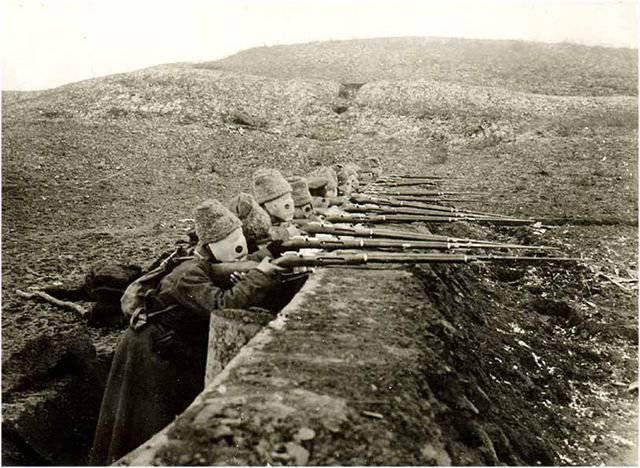
Later, White House officials lied about not using white phosphorus in the attack on Fallujah. However, under the weight of evidence, they still had to admit this fact. As a result, after a few years they even apologized, but only for deception, and not for the use of prohibited chemicals. At present, Russia, as a member of the Convention on the Prohibition of CW, continues to eliminate even the Soviet arsenals of chemical weapons. The elimination process continues in the United States. The elimination of chemical weapons is a very complex process that requires great precaution.
The problem of the disposal of chemical weapons has acquired great importance in the framework of the agreement between Russia and the United States on the elimination of chemical weapons in Syria. Countries will control this process together. At the same time, it is planned to destroy the Syrian chemical weapons already in 2014. However, there are still questions about how much money and how it will happen. Russian Foreign Minister Sergey Lavrov spoke well at the expense of money for recycling: "If there is a group of countries willing to spend money on war, then there will surely be those who will be willing to pay for a peaceful resolution of the conflict."
The main methods of disposal of chemical weapons
The significance and importance of the problem of the disposal of chemical weapons attract the attention of many specialists working in various fields of science, which is expressed in a large number of methods for the destruction of chemical weapons. At the same time, experts identify 3 of the main groups of utilization methods: thermal, chemical and biological.
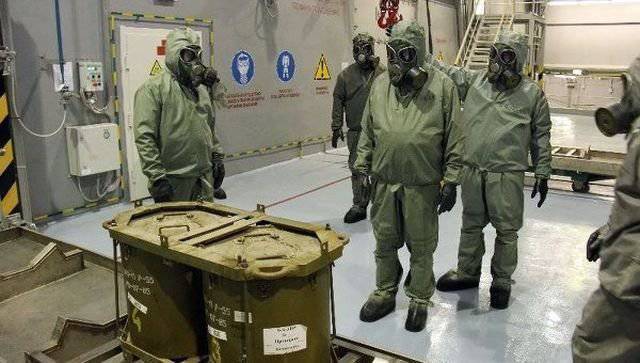
1. Chemical methods of utilization of CW are based on their reactions with various chemical reagents, as a result of which non-toxic products are formed. For example, alkaline hydrolysis. The hydrolysis of XO in special aqueous solutions of alkalis proceeds with the formation of methyl alkylphosphoric acid salt, which is not a toxic compound. Since hydrolysis proceeds rather slowly in a weakly alkaline and neutral medium, this method can only be used for detoxifying toxic substances in the laboratory.
Oxidative chlorination. In this method, chlorine, sodium and calcium hypochlorite, and hydrogen peroxide are used as an oxidizing agent. Due to the high reactivity of these substances, the decomposition of chemical substances may be accompanied by an explosion, therefore, these reactions with toxic substances can be carried out in suspensions or aqueous solutions. Direct chlorination of VX type substance solutions is also possible. The completeness of the destruction of agents with this method is 99,99%.
Alcoholysis can also be used. This method of CW recycling is based on the interaction of chemical agents with various alcohols and their derivatives. For the disposal of chemical weapons are most suitable monoethanol.
2. Thermal methods of utilization of CW imply the use of thermal effects on toxic substances. Such methods can be applied, both with preliminary demilitarization of chemical ammunition, and without it. The process of burning chemical agents in a special mixture with heavy liquid fuel is today one of the easiest ways to dispose of chemical weapons. Studies conducted in laboratory conditions clearly demonstrate that the process of combusting XO involves a very high degree of their destruction, as well as a very high efficiency of absorption of toxic waste gases.
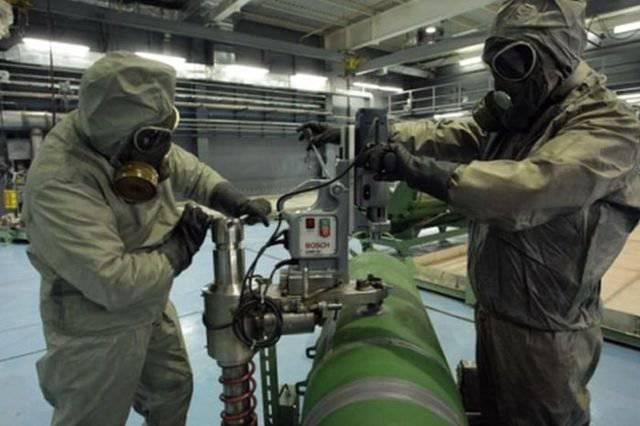
The thermal method also involves the utilization of CW in the molten salt. With this method, the OM to be disposed of is burned in the melt of a mixture of alkali metal salts. The laboratory facility, which is designed to incinerate chemical weapons in molten salts, includes the 4 element: a furnace, a combustion chamber, a combat material supply system and an exhaust gas monitoring system. The mixture of chemical agents with compressed air enters the bottom of the combustion chamber through an aluminum pipe, where the chemical reaction of the chemical agents takes place with the molten salts. Completeness of destruction of agents with this method is 99,99%.
The thermal destruction of chemical weapons in ammunition consists in decomposing chemical agents in a confined space without access to oxygen. Thermal destruction can be used to destroy chemical agents directly in ammunition, which have a significant margin of safety in relation to internal pressure. When chemical munitions are heated to high 150˚C temperatures, the internal pressure increases significantly as a result of the thermal expansion of the chemicals.
Upon further heating of the ammunition to temperatures above 200˚С, the internal pressure in them reaches the limit values and depressurization of the ammunition case is carried out, which is accompanied by the release of gaseous products ranging from 30% to 40% of the initial volume of the substance. The resulting gaseous products are used for further thermal decomposition, which is carried out on a catalyst heated to 500 доC, after which the gases are fed to an alkaline scrubber. The further process of heating the ammunition casing ensures their complete neutralization. Depending on the duration and rate of heating, the degree of destruction of chemically hazardous substances from 90% to 99% can be achieved.
3. Biological method of disposal of chemical weapons. Abroad, an assessment was made of the possibility of using microorganisms for the disposal of toxic substances. In 1946, a special enzyme was even discovered, which was designated as DFF (diisopropyl fluorophosphate). Given the availability of industrial production, the direction using biological methods can be considered promising.
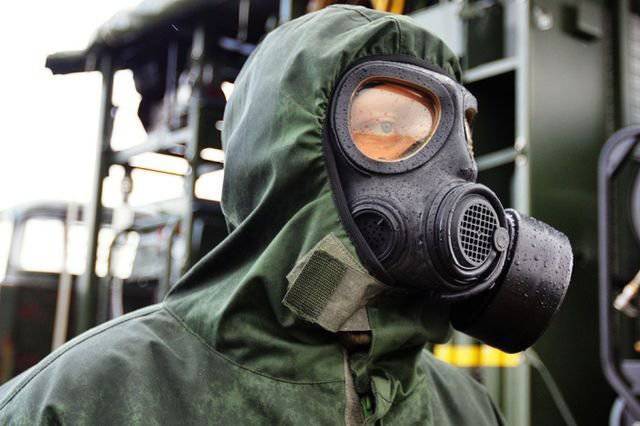
Comparative methodology shows that each method has its own advantages and disadvantages. For example, methods for the destruction of chemical waste using dilute alkalis, gaseous chlorine are associated with the release of a large volume of wastewater and corrosive media, which, in turn, leads to a significant increase in financial costs. These methods are not recommended for large-scale disposal.
Along with this, the method of direct combustion of organic substances has several advantages. This is the shortest way to dispose of chemical waste with a minimum amount of waste. However, the burning of chemicals is accompanied by the formation of vapors and aerosols, in case of accidents at the facility, the release of these substances into the atmosphere is possible. In addition, the combustion process is accompanied by such undesirable factors as work on contaminated equipment and the supply of CW to the furnace by a pump under pressure.
The safest disposal method is thermal decomposition directly in the munitions themselves, without prior demilitarization. But this method can be used only with small ammunition, the mass of toxic substances in which does not exceed 10 kg. The method of burning chemical weapons with alkali metal salts is rather complicated in terms of apparatus, and the biological method, although promising, is not well understood.
Recycling process in Russia
Russia received about 40 thousand tons of chemical weapons stockpiles from the USSR (in the USA 31,5 thousand tons), most of the Soviet chemical weapons were represented by the following substances: mustard gas, lewisite, a mixture of lewisite-mustard (HL), Soman, Zarin and VX. Russia, as a signatory to the Convention on the Elimination of Chemical Weapons, is actively destroying it. By 2013, it was possible to eliminate about 70% of the entire Russian CW.
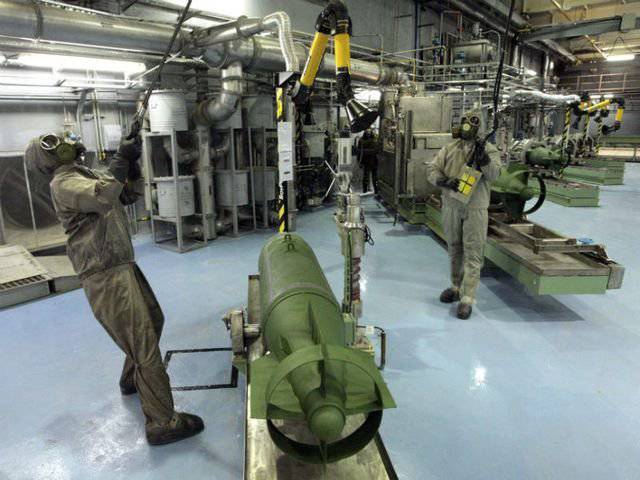
For these purposes, special enterprises were built in our country: Gorny village (Saratov region, recycling completed in 7 year), Kambarka city (Udmurt Republic, recycling completed in 2012 year), Kez village (Udmurt Republic, under construction), village Maradykovo (Kirov Oblast, valid from 2012 of the year), Shchuchye (Kurgan Oblast, effective from 2006 of the year), Leonidovka village (Penza Oblast, valid from 2009 of the year), Pochep (Bryansk Oblast, valid from 2008 of the year).
Currently, Europe’s largest chemical liquidation plant operates in the Bryansk city of Pochepe. The plant operates around the clock. Day and night, 3 fully automatic lines produce, in technical terms, “discharging ammunition” of various calibers. Everyone who goes to his shop, puts on a special hermetic suits. These suits are absolutely safe, but you can stay in the workshops of the workers in no more than 4 hours.
Sergei Uvarov, who is the head of the special ammunition storage department, says that depending on the caliber, the bombs store up to 270 kg. chemical reagents, in order to dispose of such an ammunition, it takes 5 minutes. The main profile of the enterprise in Pochep is recycling aviation bombs loaded with Soman, Sarin and VX. All these substances are the strongest toxins that can block the impulses of the human nervous system and lead to complete muscle paralysis and respiratory arrest. For this reason, the entire ammunition disposal process takes place inside fully sealed automated stations. People are only engaged in monitoring their work.
First, the ammunition goes through a weighing procedure, after which it is sent to a sealed chamber, in which an operation is performed on puncturing the hull and removing the OM from it. In the event of a possible leak (for the whole time there was not one), on the territory of the enterprise constant monitoring of dozens of different parameters is carried out, and the personnel working here are undergoing special training. However, before people get into the danger zone, the PW will be neutralized.
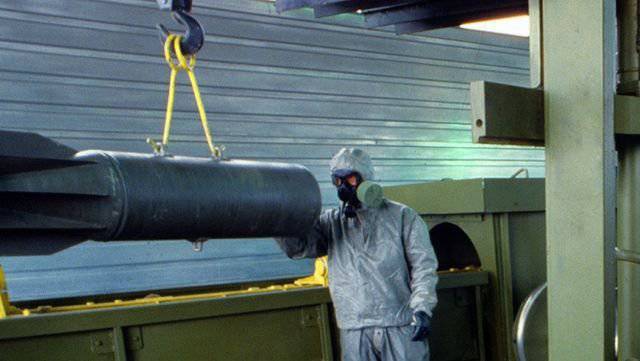
From the central control station, automated control over the course of CW destruction is conducted. Here are the workstations of operators. After the poisonous substance was neutralized with the help of special reagents, and the shells of ammunition went to the kiln, the resulting low-toxic mass is fed to the final stage of thermal neutralization.
In huge furnaces, with the help of burning natural gas, a temperature of the order of 1200 degrees is maintained. Under the influence of such a temperature, the incoming masses are decomposed into sludge and flue gases. Russia is ready to use its experience in destroying chemical agents in Syria today. At the enterprise in Pochep, they are assured that they are able to dispose of the Syrian chemical weapons in any conditions. The experience gained here makes it possible to adjust the process of CW destruction in a matter of days. At the same time, if there is a political solution, it will be possible to eliminate Syrian chemical weapons stocks at Russian sites.
The complete elimination of the Russian chemical weapons arsenal should end in 2015, in the year of the centennial of the world's first large-scale combat use of chemical weapons. After that, the company will be redeveloped for civilian use. As a result, practically nothing will remind him of his past, and only a white substance, similar to chalk, will remain from the chemical agent. The entire process of processing highly toxic poisons into this substance safe for people takes 3 hours.
Information sources:
-http: //www.vesti.ru/doc.html? id = 1130018
-http: //www.techros.ru/text/2745
-http: //lenta.ru/news/2013/01/31/chemistry
-http: //ru.wikipedia.org
Information